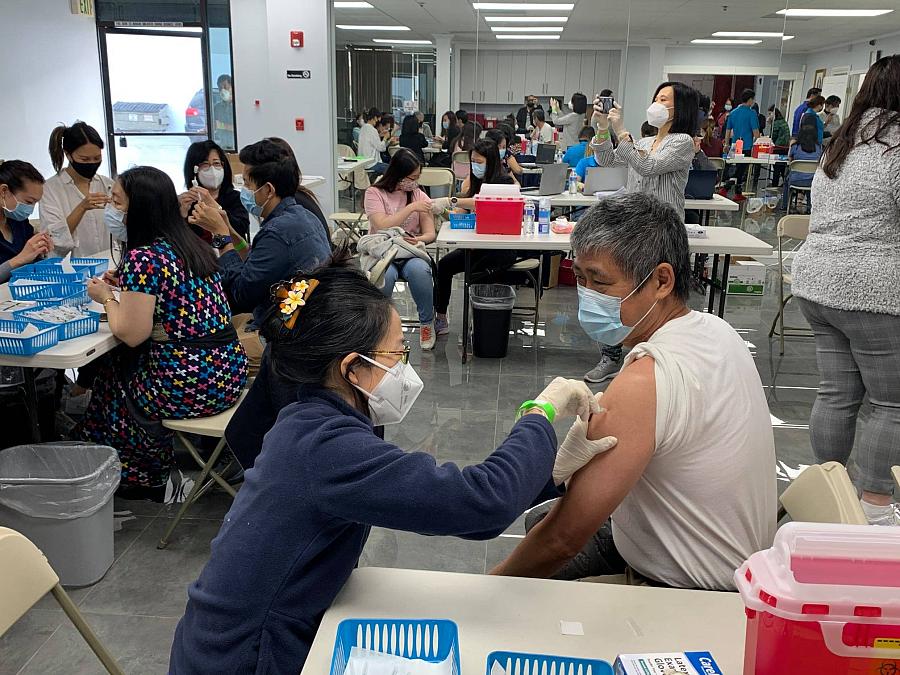How the COVID-19 pandemic impacted Burmese living in the U.S.

A vaccination clinic for the Burmese community on April 3 in El Monte, California.
The Myanmar American community living in California, New York and Indiana States was hit hard by the COVID-19 pandemic. Those working in meat processing plants, factories, supermarket sushi bars and health workers were highly impacted by the virus. Others got sick after gathering in the religious events in Myanmar Buddhist monasteries.
For my 2021 California Fellowship, I will report on some of these superspreader events. I’ll also consider the larger challenges impacting the Myanmar community. Small businesses are in economic hardships due to public health restrictions; children are suffering from academic problems and loss of social connection with their friends, as well as high levels of stress and some psychological problems. There are anti-Asian incidents in many places, due to the origins of the virus and the ensuing racist rhetoric.
Places to focus on: In Los Angeles there are different organizations like the Southern California Burmese Association, Southern California Burma Chinese Association, Burmese American Dental Organization, Myanmar American Medical Association, Burmese American Welfare Association, Southern California Shan Cultural Society, and Burmese refugee group in Orange County. There are 15 Burmese Buddhist monasteries, five Burmese Christian churches and one Muslim mosque in Los Angeles.
In the San Francisco Bay area, there is a big Burmese organization, “One Myanmar Community.” There are five Burmese Buddhist monasteries in the Bay Area. In Fresno and In Las Vegas, there is one Burmese Buddhist monastery each.
These are religious places but they are also community centers where most events are celebrated and most Burmese people gather. These places are good sources of data on Burmese people and will provide some new sources too. I have been working with different Burmese community organizations in California since 2006 for reporting and for organizing community events. We used to meet in person at least once a week before the pandemic. They will help me in this project as well.
I will explain to the organizations and religious leaders my project and its objectives and will ask them to connect me with Burmese people willing to participate in my project. Then, I will organize small groups for meetings and for taking surveys. I will interview people about how they have been profoundly impacted by COVID-19. I will take photos, audio and video records after getting permission from them.
After the reporting
After my reporting process, I have three things to do.
I will recap the different experiences to fight COVID-19 during pandemic in stories published in the Myanmar Gazette.
I will share results from the community feedback survey questions in the Myanmar Gazette.
And I will meet with community leaders to discuss how to solve these problems, reviewing the weaknesses and loopholes in the community response and detailing better approaches for accessing health care and information in the future.
I am working with Ethnic Media Services (EMS), which has strong connections with LA County Public Health.
One important objective for my project is to provide a reference for others who may do other health projects in the future on and for the Burmese community in the United States.
COVID-19 vaccinations
The Burmese community started to provide COVID-19 vaccinations in the community on April 3, 2021 at Dynasty Theater in El Monte, California. The vaccine provider is a Burmese-owned pharmacy. About 700 people got vaccinated on that first day. I interviewed the vaccine providers, volunteers and people who vaccinated on that day. More COVID-19 vaccination services will be offered in the Burmese community soon and I would like to cover those efforts.
I will meet with the community in different places and ask them the questions about their understanding and beliefs about COVID-19 vaccines, why they are getting vaccinated or why they declined to get vaccination, as well as the difficulties and barriers they met to get vaccinations.

